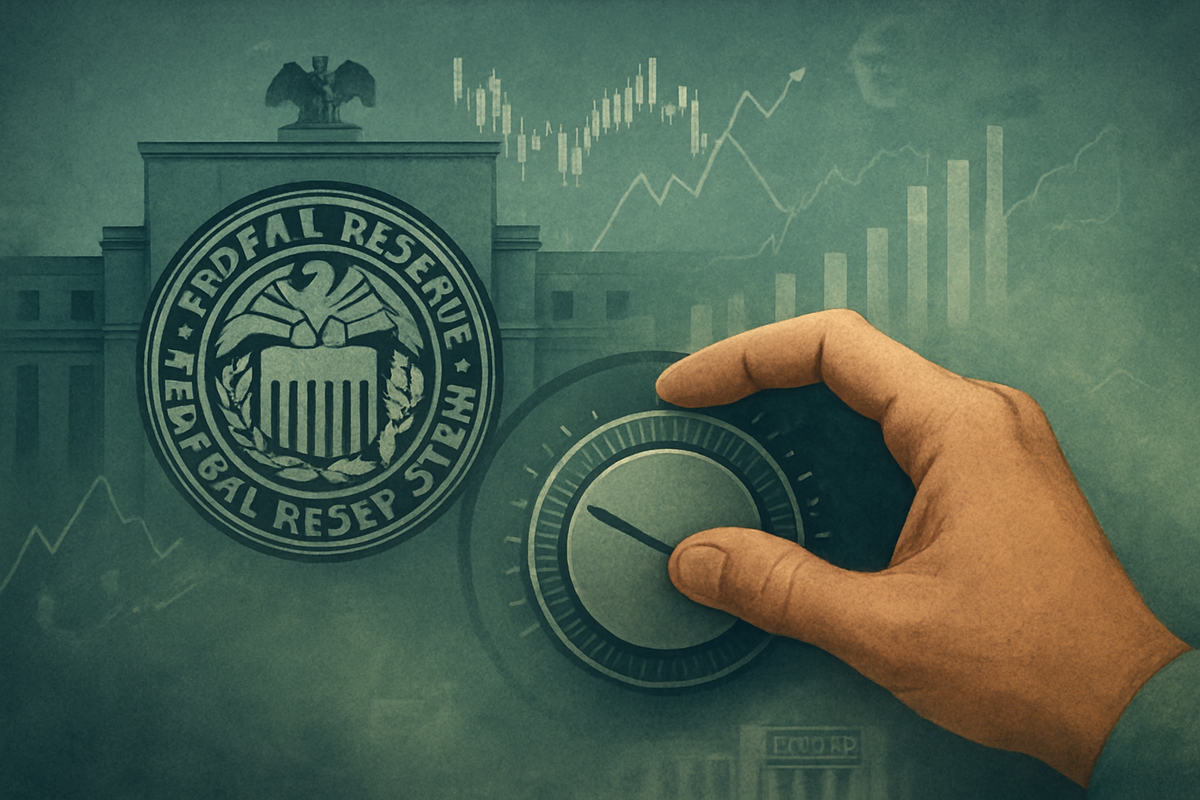
The Federal Reserve has made a pivotal shift in its monetary policy, announcing on October 29, 2025, a halt to its balance sheet reduction program, known as quantitative tightening (QT), effective December 1, 2025. This significant decision coincides with a 25 basis point reduction in the federal funds rate, lowering the target range to 3.75%-4.00%. This marks the second consecutive rate cut, following a similar reduction in September. This strategic pivot firmly re-establishes the federal funds rate as the central bank's preferred and primary tool for managing monetary policy, aiming to stabilize financial markets and support a weakening labor market.
The immediate implications of these actions are multifaceted, signaling a cautious easing stance designed to inject liquidity into the financial system and reduce borrowing costs across the economy. While the move is largely seen as supportive for risk assets and economic growth, it comes amidst persistent inflation above the Fed's 2% target and a complicating federal government shutdown, creating a complex and uncertain outlook for investors and businesses alike.
A Decisive Shift: Halting QT and Cutting Rates
The Federal Open Market Committee (FOMC) concluded its October 29, 2025, meeting with a series of announcements that underscore a significant reorientation of monetary strategy. The most prominent among them is the cessation of quantitative tightening (QT), which will see the Fed stop allowing up to $5 billion in Treasury securities to mature each month without replacement. Instead, it will maintain its stock of government bonds by rolling over maturing Treasuries. This effectively halts the shrinking of the balance sheet, which had declined from a peak of nearly $9 trillion to approximately $6.6 trillion. The decision to end QT was explicitly driven by recent market strains and tightening money market liquidity. Furthermore, while the Fed will continue to allow up to $35 billion in mortgage-backed securities (MBS) to expire monthly, all proceeds from maturing MBS will be reinvested into Treasury bills, shifting the portfolio's composition away from mortgage exposure.
Accompanying this balance sheet adjustment, the FOMC voted 10-2 to lower the federal funds rate by 25 basis points, setting the new target range between 3.75% and 4.00%. This was largely anticipated by financial markets, reflecting growing concerns over a "waning" job market and increasing "downside risks to employment." Federal Reserve Chair Jerome Powell indicated that the decision to halt balance sheet runoff was a response to market strains over the past three weeks, emphasizing that it was the "right time to stop." However, Powell also cautioned that a further rate cut in December is "not a foregone conclusion," highlighting internal divisions and the complex data environment exacerbated by the ongoing government shutdown, which has halted the release of crucial economic indicators. Initial market reactions were mixed, with bond yields under some pressure amid a stock rally, while equity markets reacted with tempered enthusiasm, balancing easing financial conditions against Powell's cautionary remarks.
Winners and Losers in the New Monetary Landscape
The Federal Reserve's pivot towards easing monetary conditions, characterized by lower interest rates and increased market liquidity, will create distinct winners and losers across various sectors and public companies.
Winning Sectors and Companies:
- Real Estate and Homebuilding: This sector stands to be a major beneficiary. Lower federal funds rates typically translate to lower mortgage rates, increasing consumer purchasing power and demand for housing. Homebuilders like D.R. Horton (NYSE: DHI) and Lennar (NYSE: LEN) could see increased sales and construction activity. Real Estate Investment Trusts (REITs), often carrying substantial debt, will benefit from reduced borrowing costs for their portfolios, improving cash flow and potentially driving property values higher.
- Growth-Oriented Companies (Technology, AI Infrastructure): Companies that rely heavily on debt financing for research, development, and scaling operations, and whose valuations are tied to future earnings, will thrive. Cheaper capital makes it more affordable to fund ambitious initiatives, accelerating growth. Technology giants such as NVIDIA (NASDAQ: NVDA) and Microsoft (NASDAQ: MSFT), alongside smaller, high-growth tech firms, will find financing more accessible, leading to higher stock valuations as lower discount rates enhance the present value of their projected future earnings.
- Interest-Sensitive Sectors (Utilities, Infrastructure, Consumer Discretionary): Utilities (e.g., National Grid (NYSE: NGG)) benefit from cheaper financing for their extensive infrastructure projects. Consumer discretionary companies like Tesla (NASDAQ: TSLA) and Apple (NASDAQ: AAPL) could see a boost as lower interest rates stimulate consumer credit and spending on non-essential goods and services.
- Highly Indebted Companies: Businesses across various sectors with significant existing debt loads will see a direct positive impact through reduced interest expenses, freeing up cash flow for investments or shareholder returns.
Losing Sectors and Companies:
- Banking Sector (Mixed Impact): While lower rates can stimulate loan demand, they can also compress net interest margins (NIMs)—the difference between what banks earn on loans and what they pay on deposits. A flatter yield curve could reduce bank profitability. However, increased lending volume and lower loan defaults due to an improving economy could offset some of this pressure. Regional banks might specifically benefit from improved liquidity.
- Savers and Fixed Income Investors: Lower interest rates directly reduce the returns on savings accounts, certificates of deposit (CDs), and newly issued bonds. Individuals relying on interest income will see diminished returns, and the attractiveness of fixed-income assets decreases relative to equities.
Wider Significance: A Return to Conventionality Amidst Uncertainty
The Federal Reserve's decision to halt quantitative tightening and cut interest rates is a significant pivot that reverberates across broader industry trends, impacts global financial dynamics, and carries important regulatory implications. This move solidifies the federal funds rate as the primary monetary policy tool by maintaining ample reserves in the banking system, thereby ensuring the smooth functioning of money markets and effective rate control.
This policy shift is expected to reshape the housing market, with lower mortgage rates stimulating demand and encouraging refinancing. Technology and growth sectors are poised for substantial benefits from accessible and cheaper capital. The financial industry faces a nuanced outlook, with potential net interest margin compression for banks balanced by increased lending activity. Globally, this U.S. monetary easing could usher in a "synchronized policy easing phase," influencing other central banks to adjust their policies and potentially leading to a weaker U.S. dollar, which would benefit American exports and reduce debt servicing costs for emerging markets with dollar-denominated debt.
Regulatory and policy implications include renewed pressure on fiscal policy if monetary measures prove insufficient, a reinforced focus on the Fed's dual mandate with an emphasis on employment, and ongoing discussions about the balance sheet's composition. There's also growing scrutiny and calls for transparency regarding the Fed's regulatory role. Historically, periods of rate cuts driven by a weakening job market have often preceded or accompanied economic slowdowns. The cessation of QT is informed by past liquidity crunches, aiming to restore ample reserves. The current situation also highlights the perennial challenge of making timely and accurate monetary policy decisions during periods of economic uncertainty, especially with the added complexity of the ongoing government shutdown. The shutdown, which began on October 1, 2025, has created a "data fog," hindering the Fed's access to crucial economic indicators and forcing it to operate "a little bit blind," thus adding an extra layer of uncertainty to its policy outlook and potentially exacerbating economic impacts.
What Comes Next: Navigating a Shifting Economic Landscape
The Federal Reserve's pivot towards easing monetary conditions sets the stage for a dynamic period, presenting both opportunities and challenges in the short and long term. The immediate future will be heavily influenced by the interplay between the Fed's dovish stance, persistent inflation, and the lingering impact of the government shutdown.
In the short term, consumers and businesses will experience lower borrowing costs, which is expected to stimulate spending, investment, and hiring. Mortgage rates, in particular, are likely to continue their decline, providing a boost to the housing market. However, savers will face diminishing returns on high-yield accounts. The U.S. dollar is anticipated to weaken, potentially making American exports more competitive. The halt in QT will inject liquidity, supporting risk assets and potentially pushing Treasury yields lower. The primary challenge remains the "data blindness" caused by the government shutdown, making it difficult for the Fed to precisely gauge economic conditions and for markets to anticipate future moves.
Long-term possibilities include a potential reignition of inflationary pressures if the easing is too aggressive, as lower rates increase the money supply. Conversely, the policy aims to support sustained economic growth and employment. For businesses, strategic pivots include exploring debt refinancing, investing in R&D and expansion, and capitalizing on increased M&A activity. Investors should consider reallocating towards growth-oriented equities (technology, housing, consumer discretionary), high-quality fixed income, and commodities like gold and silver as inflation hedges.
Several scenarios could unfold:
- "Soft Landing" (Base Case): The Fed's actions successfully stimulate growth and employment without reigniting significant inflation.
- "Sticky Inflation, Modest Growth": Rate cuts provide some stimulus, but inflation remains persistent, leading to a slow economic recovery.
- "Inflationary Re-acceleration": Aggressive easing causes inflation to surge, forcing the Fed to reverse course and tighten again.
- "Lingering Weakness/Stagflationary Risk": Despite cuts, underlying weaknesses persist, leading to sluggish growth and elevated inflation.
The ongoing government shutdown adds significant uncertainty, potentially delaying economic recovery and complicating the Fed's ability to respond effectively.
Comprehensive Wrap-up: A Cautious Path Forward
The Federal Reserve's recent monetary policy decisions—halting quantitative tightening and implementing interest rate cuts—represent a critical juncture, signaling a clear prioritization of supporting employment amidst a complex economic backdrop. The federal funds rate is now unequivocally cemented as the primary tool for navigating these crosscurrents.
Key takeaways include the Fed's aggressive move to ease financial conditions, driven by concerns over a weakening labor market, despite inflation remaining above target. The cessation of QT aims to ensure ample liquidity and prevent market strains. However, internal divisions within the FOMC and the "data fog" caused by the ongoing government shutdown underscore the significant uncertainty surrounding the path ahead.
Moving forward, markets will likely see continued support for equities, particularly growth-oriented and interest-sensitive sectors. Bond yields may face downward pressure from the end of QT, but inflation concerns could cap significant declines. The U.S. dollar is expected to weaken, potentially benefiting exports and emerging markets. The overall economic outlook suggests moderate growth, but with lingering risks of a softening labor market and the direct impact of the government shutdown on GDP.
The significance and lasting impact of this pivot lie in the Fed's willingness to tolerate elevated inflation to safeguard employment, marking a departure from its recent hawkish stance. The challenges posed by the government shutdown to data-driven policymaking could erode confidence and highlight the need for greater transparency.
Investors should watch for the resolution of the government shutdown, as it will unlock crucial economic data. Close monitoring of inflation and labor market indicators, even from alternative sources, will be paramount. Scrutinizing all Federal Reserve communications for nuanced language on future rate projections and internal consensus is also critical. Reassessing cash and fixed-income allocations, maintaining quality equity exposure, and diversifying portfolios will be crucial strategies in the coming months. The period ahead will demand adaptability and vigilance from all market participants.
This content is intended for informational purposes only and is not financial advice






